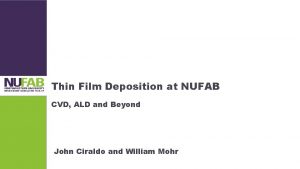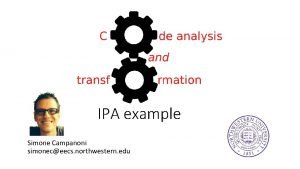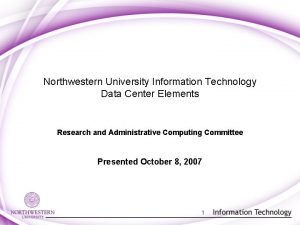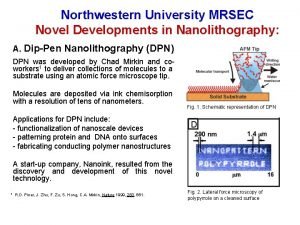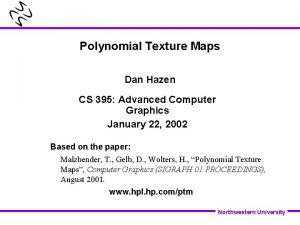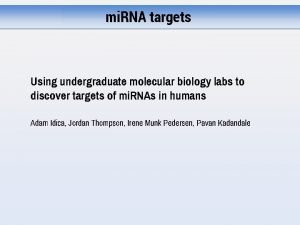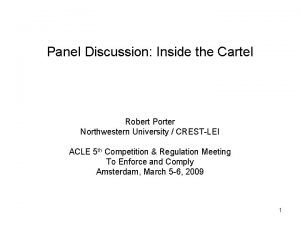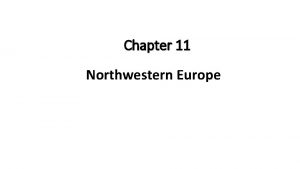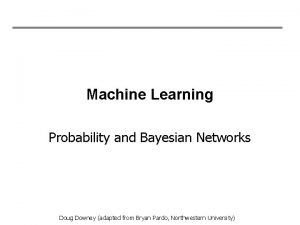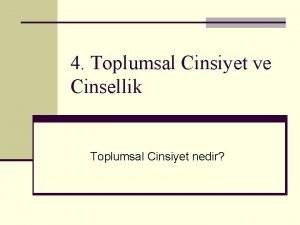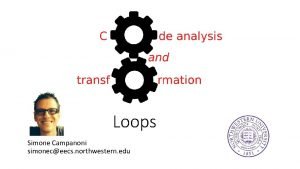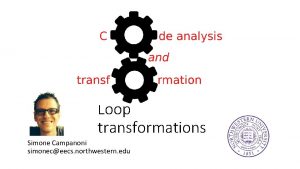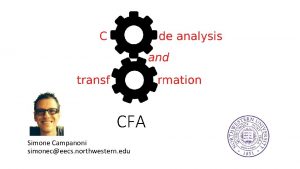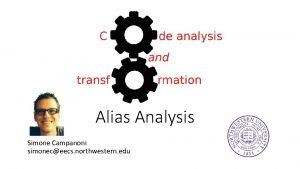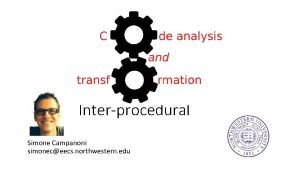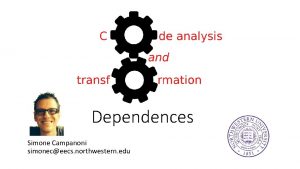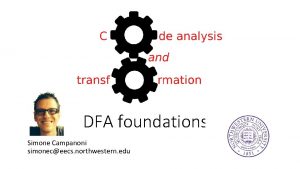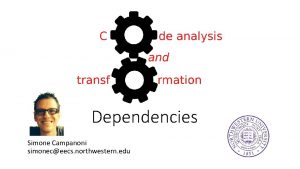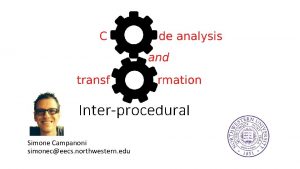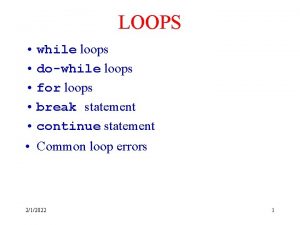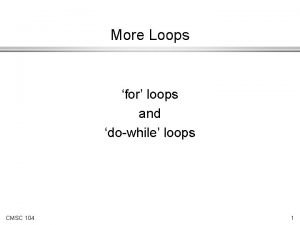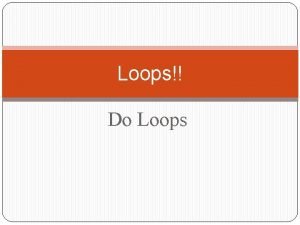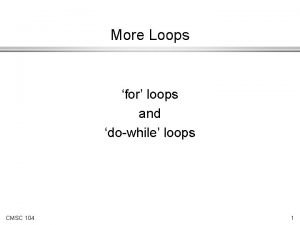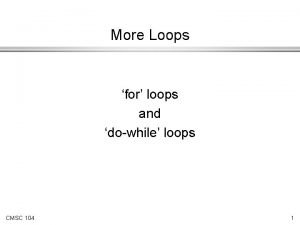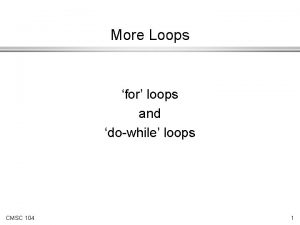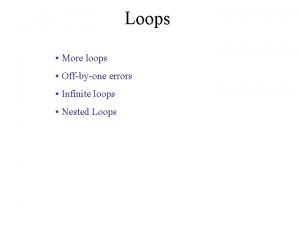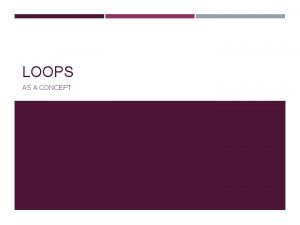Loops Simone Campanoni simoneceecs northwestern edu Outline Loops









































- Slides: 41

Loops Simone Campanoni simonec@eecs. northwestern. edu

Outline • Loops • Identify loops • Loop normalization

Impact of optimized code to program Code transformation 10 seconds 1 second How much did we optimize the overall program? • Coverage of optimized code • 10% coverage: Speedup=~1. 10 x (100 ->91 seconds) • 20% coverage: Speedup=~1. 22 x (100 ->82 seconds) • 90% coverage: Speedup=~5. 26 x (100 ->19 seconds)

90% of time is spent in 10% of code Cold code Loop Hot code Identify hot code to succeed!!!

Loops …. . . but where are they? . . . How can we find them?

Loops in source code for (i=0; i < 10; i++){ … } i=0; while (i < 10){ … i++; } i=0; do { … i++; } while (i < 10); S={0, 1, …, 10} for (i : S){ … } Is there a LLVM IR instruction “for”? There is no IR instruction for “loop”

• Target optimization: we need to identify loops • There is no IR instruction for “loop” • How to identify an IR loop?

Loops in IR • Loop identification control flow analysis: • Input: Control-Flow-Graph • Output: loops in CFG • Not sensitive to input syntax: a uniform treatment for all loops • Define a loop in graph terms • Intuitive properties of a loop • Single entry point • Edges must form at least a cycle in CFG • How to check these properties automatically?

Outline • Loops • Identify loops • Loop normalization

Natural loops in CFG • Header: node that dominates all other nodes in a loop Single entry point of a loop • Back edge: edge (tail -> head) whose head dominates its tail • Natural loop of a back edge: smallest set of nodes that includes the head and tail of that back edge, and has no predecessors outside the set, except for the predecessors of the header.

Identify natural loops ① Find the dominator relations in a flow graph ② Identify the back edges ③ Find the natural loop associated with the back edge

Immediate dominators Definition: the immediate dominator of a node n is the unique node that strictly dominates n (i. e. , it isn’t n) but does not strictly dominate another node that strictly dominates n 1 2 2 Dominator tree 3 3 3 CFG Immediate dominators

Finding back-edges Definition: a back-edge is an arc (tail -> head) whose head dominates its tail (A) Depth-first spanning tree

Spanning tree of a graph Definition: A tree T is a spanning tree of a graph G if T is a subgraph of G that contains all the vertices of G. 1 2 3 4

Depth-first spanning tree of a graph Idea: Make a path as long as possible, and then go back (backtrack) to add branches also as long as possible. Algorithm s = new Stack(); s. add(G. entry); mark(G. entry); While (!s. empty()){ 1: v = s. pop(); 2: if (v’ = adjacent. Not. Marked(v, G)){ 3: mark(v’) ; DFST. add((v, v’)); 4: s. push(v’); }} 1 2 3 4

Finding back-edges Definition: a back-edge is an arc (tail -> head) whose head dominates its tail 1 (A) Depth-first spanning tree • Compute retreating edges in CFG: • Advancing edges: from ancestor to proper descendant • Retreating edges: from descendant to ancestor (B) For each retreating edge t->h, check if h dominates t 2 3 4

Finding natural loops Definition: the natural loop of a back edge is the smallest set of nodes that includes the head and tail of the back edge, and has no predecessors outside the set, except for the predecessors of the header Let t->h be the back-edge A. Delete h from the flow graph B. Find those nodes that can reach t 2 3 (those nodes plus h and t form the natural loop of t->h) 1 4 1 2 3 4

Natural loop example For (int i=0; i < 10; i++){ A(); while (j < 5){ j = B(j); } } 0: i=0 1: i < 10 Exit 5: i++ 2: A() 3: j < 5 4: j = B(j)

Identify inner loops • If two loops do not have the same header • They are either disjoint, or • One is entirely contained (nested within) the other • Outer loop, inner loop • Loop nesting relation Graph/DAG/tree? Why? (1 point) • What about if two loops share the same header? while (a: i < 10){ b: if (i == 5) continue; c: … }

Loop nesting tree • Loop-nest tree: each node represents the blocks of a loop, and parent nodes are enclosing loops. • The leaves of the tree are the inner-most loops. 1 1, 2, 3, 4 2 2, 3 3 4 How to compute the loop-nest tree?

Loop nesting forest void my. Function (){ 1: while (…){ 2: while (…){ … } } … 3: for (…){ 4: do { 5: while(…) {…} } while (…) } } 1 3 2 4 5 Outermost loops Innermost loops

Identify loops in LLVM • Rely on other passes to identify loops void my. Function (){ 1: while (…){ 2: while (…){ … } } … • Fetch the result of the Loop. Info. Wrapper. Pass analysis 3: for (…){ 4: do { 5: while(…) {…} } while (…) • Iterate over outermost loops } }

Loops in LLVM: sub-loops • Iterate over sub-loops of a loop void my. Function (){ 1: while (…){ 2: while (…){ … } } … 3: for (…){ 4: do { 5: while(…) {…} } while (…) } }

Defining loops in graphic-theoretic terms Is it good? Bad? Implications? L 1: … if (X < 10) goto L 2; goto L 1; L 2: . . . The good if (…) goto L 1; … do { … L 1: … } while (X < 10); The bad Implications?

Outline • Loops • Identify loops • Loop normalization

Code before a new iteration

Code before a new iteration We need to normalize loops so CATs can expect a single pre-defined shape!

First normalization: adding a pre-header • Optimizations often require code to be executed once before the loop • Create a pre-header basic block for every loop

Pre-header Common loop normalization Header Pre-header Header exit Body exit

Pre-header Common loop normalization Header Pre-header Header Body exit

Loop normalization in LLVM • The loop-simplify pass normalize natural loops • Output of loop-simplify: • Pre-header: the only predecessor of the header • Latch: node executed just before starting a new loop iteration • Exit node: ensures it is dominated by the header n 1 n 2 n. X Header exit Body n 3

Loop normalization in LLVM • The loop-simplify pass normalize natural loops • Output of loop-simplify: • Pre-header: the only predecessor of the header • Latch: node executed just before starting a new loop iteration • Exit node: ensures it is dominated by the header n 1 n 2 Pre-header n. X Header exit Body n 3

Loop normalization in LLVM • The loop-simplify pass normalize natural loops • Output of loop-simplify: • Pre-header: the only predecessor of the header • Latch: node executed just before starting a new loop iteration • Exit node: ensures it is dominated by the header n 1 n 2 n 3 Pre-header n. X Header exit Body Latch

Loop normalization in LLVM • The loop-simplify pass normalize natural loops • Output of loop-simplify: • Pre-header: the only predecessor of the header • Latch: node executed just before starting a new loop iteration • Exit node: ensures it is dominated by the header n 1 n. X n 2 n 3 Pre-header exit Exit node Header Body Latch

(Critical edges) Source Definition: A critical edge is an edge in the CFG which is neither the only edge leaving its source block, nor the only edge entering its destination block. Destination These edges must be split: a new block must be created and inserted in the middle of the edge, to insert computations on the edge without affecting any other edges. n. A n. B n 1 n 2 If (…){ while (…){ … } } A()

Loop normalization in LLVM • Pre-header • Header • Latch • Exit llvm: : Loop: get. Loop. Preheader() llvm: : Loop: : get. Header() llvm: : Loop: : get. Loop. Latch() llvm: : Loop: : get. Exit. Blocks() opt -loop-simplify bitcode. bc -o normalized. bc Pre-header Exit node Header Body Latch

Further normalizations in LLVM • Loop representation can be further normalized: • loop-simplify normalize the shape of the loop • What about definitions in a loop? • Problem: updating code in loop might require to update code outside loops for keeping SSA • Loop-closed SSA form: no var is used outside of the loop in that it is defined • Keeping SSA form is expensive with loops • lcssa insert phi instruction at loop boundaries for variables defined in a loop body and used outside • Isolation between optimization performed in and out the loop • Faster keeping the SSA form • Propagation of code changes outside the loop blocked by phi instructions

Loop pass example while (){ d=… } …. . . = d op. . . while (){ d=…. . . if (. . . ){ d =. . . } } …. . . = d op. . . while (){ d=…. . . if (. . . ){ d 2 =. . . } d 3=phi(d, d 2) } …. . . = d op. . . A pass needs to add a conditional definition This is not in SSA anymore: we must fix it of d while (){ d=…. . . if (. . . ){ d 2 =. . . } d 3=phi(d, d 2) } …. . . = d 3 op. . . Changes to code outside our loop

Further normalizations in LLVM • Loop representation can be further normalized: • loop-simplify normalize the shape of the loop • What about definitions in a loop? • Problem: updating code in loop might require to update code outside loops for keeping SSA • Keeping SSA form is expensive with loops • Loop-closed SSA form: no var is used outside of the loop in that it is defined • lcssa insert phi instruction at loop boundaries for variables defined in a loop body and used outside • Isolation between optimization performed in and out the loop • Faster keeping the SSA form • Propagation of code changes outside the loop blocked by phi instructions

Loop-closed SSA form in LLVM opt -lcssa bitcode. bc -o transformed. bc llvm: : Loop: : is. LCSSAForm(DT) form. LCSSA(…)

Further normalizations in LLVM Last loop-related normalization: Induction variable normalization
 Simone campanoni
Simone campanoni Edu.sharif.edu
Edu.sharif.edu Example of sentence outline
Example of sentence outline Yan chen northwestern
Yan chen northwestern Comp sci 110 northwestern
Comp sci 110 northwestern Pvd vs cvd
Pvd vs cvd Ying wu northwestern
Ying wu northwestern Scott baker northwestern
Scott baker northwestern Northwestern europe physical features
Northwestern europe physical features Ipa source northwestern
Ipa source northwestern Silver falls dermatology
Silver falls dermatology Northwestern mailroom
Northwestern mailroom Northwestern mutual hierarchy
Northwestern mutual hierarchy Northwestern cs 213
Northwestern cs 213 Northwestern neurobiology
Northwestern neurobiology Michael schmitt northwestern
Michael schmitt northwestern Nucore northwestern login
Nucore northwestern login Chris andrews northwestern mutual
Chris andrews northwestern mutual Northwestern it software
Northwestern it software Yan chen northwestern
Yan chen northwestern Asrsp northwestern
Asrsp northwestern Northwestern university
Northwestern university Northwestern university computer engineering
Northwestern university computer engineering David cella northwestern
David cella northwestern Northwestern coniferous forest biome
Northwestern coniferous forest biome Dr douglas vaughan
Dr douglas vaughan What is polynomial texture mapping (ptm)?
What is polynomial texture mapping (ptm)? Chris andrews northwestern mutual
Chris andrews northwestern mutual Northwestern medicine discovery program
Northwestern medicine discovery program Northwestern antivirus
Northwestern antivirus Tableau northwestern
Tableau northwestern Northwestern oligo calculator
Northwestern oligo calculator Northwestern redcap
Northwestern redcap Robert porter northwestern
Robert porter northwestern What countries are in england and northwestern europe
What countries are in england and northwestern europe Doug downey northwestern
Doug downey northwestern Fasis northwestern
Fasis northwestern Northwestern university mn pseo
Northwestern university mn pseo Nina simone biggest hits
Nina simone biggest hits Toplumsal cinsiyet nedir
Toplumsal cinsiyet nedir Simone polgar
Simone polgar Silkroad6ownowfk
Silkroad6ownowfk





